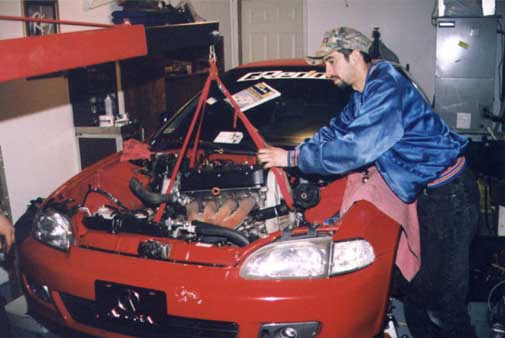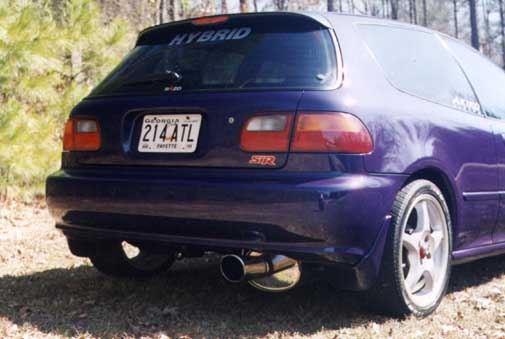
| I first started considering a motor swap after the NOPI
Nationals Super Show in September. I was growing tired of the lackluster
performance of my 93 Civic EX, but didn't have the money to add any performance
parts that would make a noticable difference. I already had a long
list of bolt ons, and apperance items, but the car was loosing its appeal.
As most of you know, this hobby only stays interesting as long as you keep
adding on...upgrading. My wallet didn't agree.
So I committed to the difficult decision of selling my first Civic, and starting a new project on another car. My first plan was to put the new GReddy turbo kit on a civic Si VTEC, but even used Si's were rare and expensive. I wanted a car with better performance, similar apperance, at a similar price. So, after alot of thinking, I decided to go with a motor swap. I sold my Civic for $11,200, and planned to invest all the money in my next car. |
 | A B16A SiR motor was my first choice, but a GSR motor seemed more appealing
overall. First, I bought a 92 Civic DX hatchback. It was in
good body condition with only minor door dings, but it had high mileage.
That wasn't an issue though, all drivetrain and suspension components would
be replaced. I got a good deal, $3700 for the car in perfect running condition.
Still, I hadn't located a motor yet. I can't possibly stress the
importance of proper and extensive planning before starting into a project
like this. Get all the info about the swap before you buy anything.
Where I live, in Georgia, few mechanics have ever heard of, or done a swap
like this. So, I obtained all the info possible on this swap to aid
in the install.
|
| I eventually found a motor by going into an import racing
chatroom on AOL and typing in, "WHO HAS A GSR MOTOR FOR SALE???"
Three guys answered, and I bought a motor from one of them. The motor
was a 96 B18C GSR with all components necessiary for the swap. The
motor also came with an enormous list of performance products including
MSD ignition, DC Header, Ceramic 8 puck Clutch, JG Eng. Dyn. VTEC cams,
and Weapon R intake. The motor was bought for $2500 with all parts
and only around 25 K miles on it. Shipping was expensive, $1000 just
for the shipping. I could have gotten it alot cheaper, but I din't
call enough shipping companies to compare prices. See, the importance
of research.....
The motor arrived about 10 days later and was transported to the mechanics
house to do the swap there. The mechanic, Joe Comonte, had never
done this swap, but was very knowledgable and resourceful. He had
all the equipment at his house needed. The charge for the install
was $550 for labor, and I ended up having to buy a few small parts.
Overall, had the motor been in perfect condition on arrival, and all the
parts there, the swap would have taken no more than a few days max using
hand tools and working in free time. However, the ECU did not come
with the motor upon shipping, and took an additional 2 weeks to arrive.
So the car sat, dismantled for two weeks with the motor in and everything
except the ECU present. The swap on my car was absolutley straightforward.
There was nothing different about the physical install from a stock motor.
Everything fits like stock. We took off the AC to reduce weight.
Next, I had to have an exhaust extension welded in to fill the gap between the shorter than stock GSR header, and the stock Civic cat converter. The friendly men at Midas Muffler reccomended installing a flex pipe, which would be able to bend when the engine torques back under hard exceleration. This would prevent the exhaust flanges from snapping after prolonged stress. Personally, if the stock GSR doesn't need a flex pipe, why should my car? That is what rubber exhaust hangings are for. But the flex pipe went in anyway. |
| All said and done, the car seemed to drive fine, but lacked
that characteristic GSR power. We traced the source back to the knock
sensor wire not being hooked up, thus disabling the VTEC. As I later
found out, most all ECU harnesses on early 92 Civics already have 2 of
the 3 VTEC wires present, whether the origional motor was VTEC or not.
In conclusion, the total project came out costing me under $12,000, and that is with new paint and minor body work (to fill door dings), racing wheels w/ nitto tires, all the performance and suspension parts, stereo, and alarm. The reason this was so cheap was due to my extensive research and shopping around for the absolute best price on everything. I probobally amassed around 40 hours of long distance calls to shops in CA, and hundreds of hours on the internet gathering info on the swap. If I could reccomend anything to future swap canidates, it would be this: Do your research on EVERYTHING, call as many places as possible to get best prices on parts and labor, try to do as much of the labor as possible yourself to save money, check the condition of the motor on arrival and before install to insure quality. It is easier to repair internal problems (like clutch fork) and make adjustments while the motor is out. Have all the parts available and ready before starting the install. The total time it took for my swap to be complete was about 5 weeks. That is a long time to go without your car. Make sure you mechanic knows what he is doing before he starts, especially if he has never done a swap like this before. If you plan to do the swap yourself, familliarize yourself with all the steps before starting. Be prepared to run into problems during the install. Don't start the project with "just enough cash to complete the swap". You might run into problems like me, and not have the funds to do the repair. Luckily, I had planned ahead for such an occassion, so I was able to finish the swap without racking up credit card debt. There is nothing worse than starting a swap, and then not being able to finish because you ran out of cash. |
Good luck to you all doing swaps. I love the car. It is
extremely fast, reliable, and streetable. This swap really isn't
as difficult as it may sound if you plan and research right. My car
should be running in the low 14's to high 13's once I get practice at the
track.......and traction!!! Thanks to Jason of Speed Image in Santa
Clara, CA, who supplied me with the motor. Also thanks to the mechanic
Joe Comonte for his skills and patience. A big thanks to Adrian of
the Hybrid site for all his help with troubleshooting and info. See
yall at the races!! |
|
|
|
|
|
|
|
(C) 1996, 1997, 1998, 1999 HYBRID Comments? Suggestions? Feedback? Send e-mail to: HYBRID editors |